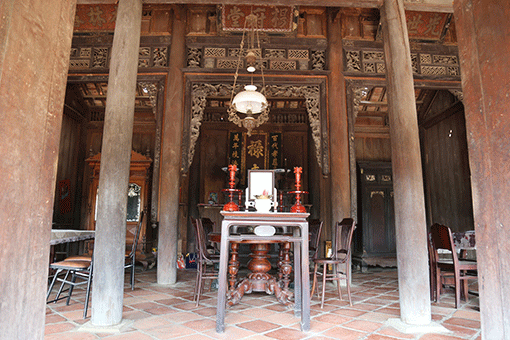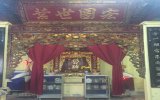An antique house preserving civil cultural values on Bach Dang islet
Antique house in Binh Duong is a type of special cultural media preserving daily life features of old-time people in Binh Duong. Up to date, Binh Duong provincial authority has approved various antique houses as provincial and national relics. Recently, Duong Van Ho House has been certified as a provincial historical and cultural remain.
An antique house of more than 100 years old
Duong Van Ho antique house is located at Dieu Hoa hamlet of Bach Dang commune in Tan Uyen town as one of the two antique houses in Bach Dang certified as a historical and cultural architectural work of the province. On August 25, Binh Duong provincial People’s Committee decided to certify Duong Van Ho House as a a historical and cultural architectural work of the province.
Duong Van Ho House is a dominant wooden house lying peacefully within an orchard on Bach Dang islet. The house was constructed by Tran Huu Nham (father-in-law of Duong Van Ho) in 4 years from 1911 through 1914. According to the family, the construction of the house hand been costly in terms of efforts and money. The house owner had ‘summoned’ famously skillful carpenters from Quang Nam, Quang Ngai, Thua Thien Hue and Binh Dinh to construct the house. Those carpenters were offered daily meals in years to stay and sculpture and decorate the house. To today, Duong Van Ho has been through 3 generations of preservation and maintenance. The first generation was Dung Van Ho, the second generation was Duong Van Banh (son of Duong Van Ho) and the third generation is Duong Tan Hoa (grandson of Duong Van Ho).

Duong Van Ho House looked from the outside

The main hall inside Duong Van Ho House
As retold by Duong Hong Diep and Duong Tan Hoa, Tran Huu Nham was a well-known merchant in the then Bien Hoa, working as fish trader among western provinces of Vietnam. He got to Binh Duong and Dong Nai by small boats and became rich by trading. In 1911, Nham started to build the house of 5 chambers on Bach Dang islet, making use of rare wood, to settle and make it a working office for his family’s trading. By 1914, the house was completed and not long after that he gifted the house to his daughter’s wedding to Duong Van Ho, a rich resident on the islet.
Duong Van Ho House was constructed on a high hill near Dong Nai River. Of more than 2,935 square meters, the housing complex includes main and secondary housing with the main housing heading to the east. The area is fenced by steel net with various types of fruit trees inside including an apricot-blossom tree of the same age as the house. The house was shaped in Chinese letter of ding (丁) which as traditionally Vietnamese housing at the time with ying-yang roofing in three chambers and two kitchens.
Valuable architectural and art values
Duong Van Ho House is valuable by its wooden structure of 50 pillars in 5 rows balanced in central construction of beams to create an antique space. The house frame was actually rare wood connected by firm cores without using nails. All were well preserved by prime finishes. The four beams of the house were specially carved in box patterns by the theme of 4 precious things (4 seasons in the year). Spring is depicted by apricot blossom, Summer daisy, Fall bamboo and Winter cedar.
The interior space is divided into separate portions of ‘house interior’ and ‘house reception’. The house interior holds two chambers from the second pillar row to the inside preserving the rest for house guest reception with 2 camp-beds and 2 sets of wooden sofas. The center from the second row pillars to the third ones is for worshiping ancestors. The utmost center is the bedroom separated by a wooden wall.
Two entrances to the bedroom were designed in semi-circular shape with sculptured patterns. Square, rectangle and hexagon decorations are on top with sophisticated carving. At the 3 central chambers, the house owner puts 2 cupboard to contain things of both side families with ancestor altar in the middle. At the two sides of the altar are parallel verse of golden Chinese letters, meaning the respect for piety from generation to generation.
Beside, the antique house has covering frames decorated with legendary animals like phoenix, unicorn, squirrel, does and holy plants. All have been skillfully sculptured along with intact Chinese letters. Generally, the patterns had been shown by wood sculpture, skillfully to the details by the talented craftmanship at the time.
Aside from the main housing, within Duong Van Ho House premise is a secondary housing in horizontal position connected to the main housing. The secondary construction is also wooden of common decoration as a place of daily meeting, conversation, work, and living as well as common guest reception.
According to Le Van Phuoc, Director of Binh Duong provincial Museum, Duong Van Ho House was constructed over 100 years ago on Bach Dang islet to carry the particular architecture of the traditional housing in the South of Vietnam in the old time. Through up and down of nature challenges and urbanization, the house has been well preserved by generations and become a unique wood construction staying in tact in Binh Duong.
The house is not purely the shelter but a place for family life, a valuable evidence of foundation and development of Bach Dang islet which is a place of cultural values of locals. The architectural and interior arrangement gave us better gasp of lives of generations through the house. The parallel verses in Chinese letters are popular decoration of animals and plants within the house as the cultural features of people in the old time, depicting their wishes and hope for more prosperous and peaceful life at the house.
Reported by Hong Thuan - Thanh Dan - Translated by Vi Bao
- Three Vietnamese female referees to officiate at U17 Women's Asian Cup finals (24/04)
- Vietnam joins ASEAN Film Festival in London (24/04)
- The 2024 "Ripe Fruit Season" Festival is slated for early June (23/04)
- Tourists come in great numbers to Dien Bien Phu (22/04)
- Binh Duong has one more Vietnamese Heritage Tree (22/04)
- Dien Bien photo exhibition captures heritage across country (21/04)
- In the forest of history (20/04)
- Google Arts & Culture exhibition spotlights Trang An Landscape Complex (19/04)
 Vietnam joins ASEAN Film Festival in London
Vietnam joins ASEAN Film Festival in London
 Three Vietnamese female referees to officiate at U17 Women's Asian Cup finals
Three Vietnamese female referees to officiate at U17 Women's Asian Cup finals
 Binh Duong has one more Vietnamese Heritage Tree
Binh Duong has one more Vietnamese Heritage Tree
 Dien Bien photo exhibition captures heritage across country
Dien Bien photo exhibition captures heritage across country
 In the forest of history
In the forest of history
 Google Arts & Culture exhibition spotlights Trang An Landscape Complex
Google Arts & Culture exhibition spotlights Trang An Landscape Complex
 Khanh Hoa to host 1st international jazz festival
Khanh Hoa to host 1st international jazz festival
 Vietnamese golfer wins title at Taiwan amateur tournament
Vietnamese golfer wins title at Taiwan amateur tournament
 Rio de Janeiro seeks sport and tourism cooperation with Vietnam
Rio de Janeiro seeks sport and tourism cooperation with Vietnam
 Festivals fuel local development in Vietnam
Festivals fuel local development in Vietnam




